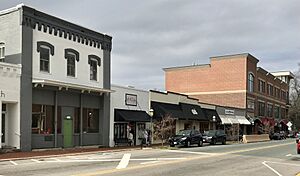Elon, North Carolina facts for kids
Quick facts for kids
Elon, North Carolina
|
|
|---|---|

North Williamson Avenue
|
|
| Motto(s):
"Deep Roots. New Horizons."
|
|

Location of Elon, North Carolina
|
|
| Country | United States |
| State | North Carolina |
| County | Alamance |
| Founded | 1881 |
| Incorporated | 1893 |
| Named for | Hebrew word for oak. |
| Area | |
| • Total | 4.22 sq mi (10.94 km2) |
| • Land | 4.17 sq mi (10.81 km2) |
| • Water | 0.05 sq mi (0.13 km2) |
| Elevation | 705 ft (215 m) |
| Population
(2020)
|
|
| • Total | 11,336 |
| • Density | 2,717.16/sq mi (1,049.03/km2) |
| Time zone | UTC-5 (Eastern (EST)) |
| • Summer (DST) | UTC-4 (EDT) |
| ZIP code |
27244
|
| FIPS code | 37-21095 |
| GNIS feature ID | 2406445 |
Elon (pronounced EE-lon) is a town located in Alamance County, North Carolina, in the United States. It is part of the larger Burlington area. In 2020, about 11,324 people lived there. Elon is also home to Elon University.
Contents
History
Elon started in 1881 as a train stop for the North Carolina Railroad. It was located between the towns of Goldsboro and Charlotte. People first called it "Mill Point" because they hoped it would be a place to ship cotton from local mills. Locals also called it "Boone's Crossing."
As more people moved to the area, a post office was built in 1888. This helped make Elon a more permanent settlement.
In 1889, a group called the Christian Assembly started a college there. They named the school "Elon" because they believed it was the Hebrew word for oak. Many oak trees grew in the area. The town was known as "Elon College" for a long time. Later, the college changed its name to Elon University, and the town officially became "Elon."
Geography
Elon is a town with a total area of about 10.2 square kilometers (about 4 square miles). Most of this area is land, which is about 10.1 square kilometers. A small part, about 0.1 square kilometers, is water.
Population Information
Here's how Elon's population has grown over the years:
| Historical population | |||
|---|---|---|---|
| Census | Pop. | %± | |
| 1900 | 638 | — | |
| 1910 | 200 | −68.7% | |
| 1920 | 425 | 112.5% | |
| 1930 | 373 | −12.2% | |
| 1940 | 494 | 32.4% | |
| 1950 | 1,109 | 124.5% | |
| 1960 | 1,284 | 15.8% | |
| 1970 | 2,150 | 67.4% | |
| 1980 | 2,873 | 33.6% | |
| 1990 | 4,394 | 52.9% | |
| 2000 | 6,738 | 53.3% | |
| 2010 | 9,419 | 39.8% | |
| 2020 | 11,324 | 20.2% | |
| 2021 (est.) | 11,350 | 20.5% | |
| U.S. Decennial Census | |||
2020 Population Details
According to the 2020 United States census, Elon had 11,336 people living there. There were 3,465 households and 1,888 families.
Most people in Elon were White, making up about 80% of the population. About 8% were Black or African American. Other groups included Asian people (about 2.5%) and Hispanic or Latino people (about 5.2%). A smaller number of people were Native American or from other racial backgrounds.
Education
The public schools in Elon are part of the Alamance-Burlington School System. This school system was formed in 1996 when the Alamance County and Burlington City school systems joined together.
Here are some of the local public schools in Elon:
- Altamahaw-Ossipee Elementary School
- Elon Elementary
- Western Alamance Middle
- Western Alamance High
As mentioned before, Elon University is also located right in Elon, North Carolina.
Transportation
Elon University runs a bus system called the Biobus. This bus system is for both university students and the general public. The buses travel from the campus to different places within Elon and the nearby areas.
See also
 In Spanish: Elon (Carolina del Norte) para niños
In Spanish: Elon (Carolina del Norte) para niños

